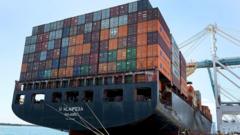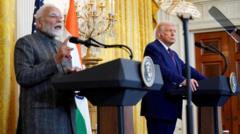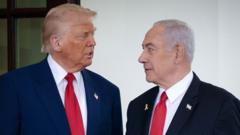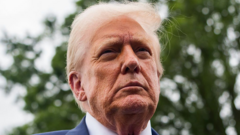The WTO's recent forecast suggests a concerning trend where global goods trade is expected to contract due to US tariffs imposed by President Trump, and potential reciprocal tariffs could worsen the situation.
**WTO Predicts Decline in Global Trade Due to US Tariffs**

**WTO Predicts Decline in Global Trade Due to US Tariffs**
The World Trade Organization warns that US tariffs are likely to shrink global trade, particularly in North America, with political uncertainties exacerbating the issue.
The World Trade Organization (WTO) has issued a stark warning regarding the implications of recent US tariffs on global trade, forecasting a decline in trade levels this year. According to the WTO's analysis, President Donald Trump's tariffs pose a "severe downside risk," which may lead to a more significant reduction in international goods trade than previously anticipated. The organization highlighted that North America, in particular, is expected to experience a trade drop exceeding 10% as a direct consequence of these policies.
Director-General Ngozi Okonjo-Iweala expressed her concerns about the ongoing "decoupling" of the US and China, describing it as a worrisome phenomenon. Earlier projections for global goods trade growth of 2.7% by 2025 have now been revised downward to a decline of 0.2%. Chief economist Ralph Ossa elaborated on the issue, stating, "Tariffs often have unexpected consequences," and stress that uncertainty surrounding trade policies dampens trade flows and economic activity.
The initial implementation of a baseline tariff of 10% on nearly all imports to the US on April 5 has led to an environment of unpredictability, particularly with regard to trade relations with China, where tariffs soar to a staggering 145% on various goods. The impacts of these tariffs have already been felt in the US stock market, which experienced a decline as the markets reacted to the uncertain trading landscape.
Despite the anticipated downturn in trade with the US, the WTO did identify that certain regions could still experience growth. Asia and Europe are projected to achieve modest increases in both exports and imports this year, indicating that the broader impact of global trade may not be uniformly negative. Notably, for the first time, the report includes forecasts for trade in services, predicting a growth of around 4% by 2025, albeit slightly lower than earlier estimates.
While President Trump asserts that these tariffs aim to stimulate domestic consumption and investment, critics argue that the complexities surrounding a return of manufacturing jobs to the US could exacerbate economic challenges in the interim. Additionally, Trump's approach to tariffs has shifted since taking office, including a temporary pause on certain levies amidst growing pushback from legislators and the markets.
Overall, the WTO's latest report underscores the far-reaching implications of US tariffs on the global trade landscape and the intricacies involved in navigating international trade relations in uncertain times.
Director-General Ngozi Okonjo-Iweala expressed her concerns about the ongoing "decoupling" of the US and China, describing it as a worrisome phenomenon. Earlier projections for global goods trade growth of 2.7% by 2025 have now been revised downward to a decline of 0.2%. Chief economist Ralph Ossa elaborated on the issue, stating, "Tariffs often have unexpected consequences," and stress that uncertainty surrounding trade policies dampens trade flows and economic activity.
The initial implementation of a baseline tariff of 10% on nearly all imports to the US on April 5 has led to an environment of unpredictability, particularly with regard to trade relations with China, where tariffs soar to a staggering 145% on various goods. The impacts of these tariffs have already been felt in the US stock market, which experienced a decline as the markets reacted to the uncertain trading landscape.
Despite the anticipated downturn in trade with the US, the WTO did identify that certain regions could still experience growth. Asia and Europe are projected to achieve modest increases in both exports and imports this year, indicating that the broader impact of global trade may not be uniformly negative. Notably, for the first time, the report includes forecasts for trade in services, predicting a growth of around 4% by 2025, albeit slightly lower than earlier estimates.
While President Trump asserts that these tariffs aim to stimulate domestic consumption and investment, critics argue that the complexities surrounding a return of manufacturing jobs to the US could exacerbate economic challenges in the interim. Additionally, Trump's approach to tariffs has shifted since taking office, including a temporary pause on certain levies amidst growing pushback from legislators and the markets.
Overall, the WTO's latest report underscores the far-reaching implications of US tariffs on the global trade landscape and the intricacies involved in navigating international trade relations in uncertain times.


















